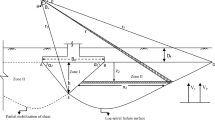Abstract
This paper presents the pseudo-dynamic analysis of seismic bearing capacity of a strip footing using upper bound limit analysis. However, in the literature, the pseudo-static approach was frequently used by several researchers to compute the seismic bearing capacity factor theoretically, where the real dynamic nature of the earthquake accelerations cannot be considered. Under the seismic conditions, the values of the unit weight component of bearing capacity factor N γE are determined for different magnitudes of soil friction angle, soil amplification and seismic acceleration coefficients both in the horizontal and vertical directions. The results obtained from the present study are shown both graphically as well as in the tabular form. It is observed that the bearing capacity factor N γE decreases significantly with the increase in seismic accelerations and amplification. The results are thoroughly compared with the existing values in the literature and the significance of the present methodology for designing the shallow footing is discussed.




Similar content being viewed by others
Abbreviations
- F i :
-
Body forces in a body of volume V
- G :
-
Shear modulus of soil
- H :
-
Maximum depth up to which the failure zone can be extended
- H a :
-
Depth up to which the failure zone is actually extended
- N γE :
-
Unit weight component of seismic bearing capacity factor
- P u :
-
Ultimate vertical failure load
- S:
-
Boundary surface of the collapse mechanism
- T i :
-
Boundary stress vector on the surface S
- T :
-
Period of lateral shaking
- V :
-
Total volume of the collapse mechanism
- V p :
-
Primary wave velocity
- V s :
-
Shear wave velocity
- a h (z, t):
-
Horizontal earthquake acceleration at depth z and time t
- a v (z, t):
-
Vertical earthquake acceleration at depth z and time t
- b :
-
Width of strip footing
- f a :
-
Amplification factor
- g :
-
Acceleration due to gravity
- t :
-
Time of vibration
- \( \ifmmode\expandafter\dot\else\expandafter\.\fi{v}^{{p*}}_{i} \) :
-
Displacement rate
- z :
-
Any depth below the ground surface
- ϕ :
-
Soil friction angle
- α :
-
Base angle of the left triangular rigid block at left footing edge
- α h :
-
Horizontal earthquake acceleration coefficient
- α v :
-
Vertical earthquake acceleration coefficient
- β :
-
Extreme right base angle of the right triangular rigid block
- \( \ifmmode\expandafter\dot\else\expandafter\.\fi{\varepsilon }^{{p*}}_{{ij}} \) :
-
Plastic strain rate compatible with displacement rate \( \ifmmode\expandafter\dot\else\expandafter\.\fi{v}^{{p*}}_{i} \)
- γ :
-
Unit weight of the soil medium
- η :
-
Wavelength of primary wave
- λ :
-
Wavelength of shear wave
- ν :
-
Poisson’s ratio of the soil medium
- ρ :
-
Mass density of the soil medium
- ω :
-
Angular frequency
- ξ h :
-
Coefficient of horizontal contribution of P u in seismic condition
- ξ v :
-
Coefficient of vertical contribution of P u in seismic condition
References
Budhu M, Al-Karni A (1993) Seismic bearing capacity of soils. Geotechnique 43(1):181–187
Chen WF, Liu XL (1990) Limit analysis in soil mechanics. Elsevier, Amsterdam
Choudhury D, Nimbalkar S (2005) Seismic passive resistance by pseudo-dynamic method. Geotechnique 55(9):699–702
Choudhury D, Subba Rao KS (2005) Seismic bearing capacity of shallow strip footings. Geotech Geol Eng 23(4):403–418
Das BM (1993) Principles of soil dynamics. PWS-KENT Publishing Company, Boston, Massachusetts
Dormieux L, Pecker A (1995) Seismic bearing capacity of foundations on cohesionless soil. J Geotech Eng, ASCE 121(3):300–303
Kumar J, Rao VBKM (2002) Seismic bearing capacity factors for spread foundations. Geotechnique 52(2):79–88
Kumar J, Kumar N (2003) Seismic bearing capacity of rough footings on slopes using limit equilibrium. Geotechnique 53(3):363–369
Kumar J, Ghosh P (2006) Seismic bearing capacity for embedded footings on sloping ground. Geotechnique 56(2):133–140
Meyerhof GG (1957) The ultimate bearing capacity of foundations on slopes. In: Proceedings of 4th international conference on soil mechanics and foundation engineering, London 1, pp 384–386
Meyerhof GG (1963) Some recent research on the bearing capacity of foundations. Can Geotech J 1(1):16–26
Richards R, Elms DG, Budhu M (1990) Dynamic fluidization of soils. J Geotech Eng, ASCE 116(5):740–759
Richards R, Elms DG, Budhu M (1993) Seismic bearing capacity and settlement of foundations. J Geotech Eng, ASCE 119(4):662–674
Sarma SK, Iossifelis IS (1990) Seismic bearing capacity factors of shallow strip footings. Geotechnique 40(2):265–273
Schnabel PB, Lysmer J, Seed HB (1972) SHAKE: a computer program for earthquake response analysis of horizontally layered sites. Report EERC 72–12, Earthquake Engineering Research Center, University of California, Berkeley
Soubra AH (1993) Discussion on seismic bearing capacity and settlements of foundations. J Geotech Eng, ASCE 120(9):1634–1636
Soubra AH (1997) Seismic bearing capacity of shallow strip footings in seismic conditions. Proc Instn Civil Engrs Geotech Engr 125(4):230–241
Soubra AH (1999) Upper bound solutions for bearing capacity of foundations. J Geotech Geoenviron Eng, ASCE 125(1):59–69
Steedman RS, Zeng X (1990) The influence of phase on the calculation of pseudo-static earth pressure on a retaining wall. Géotechnique 40(1):103–112
Zhu DY (2000) The least upper-bound solutions for bearing capacity factor N γ. Soils and Foundations 40(1):123–129
Author information
Authors and Affiliations
Corresponding author
Rights and permissions
About this article
Cite this article
Ghosh, P. Upper bound solutions of bearing capacity of strip footing by pseudo-dynamic approach. Acta Geotech. 3, 115–123 (2008). https://doi.org/10.1007/s11440-008-0058-z
Received:
Accepted:
Published:
Issue Date:
DOI: https://doi.org/10.1007/s11440-008-0058-z




